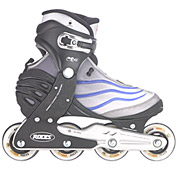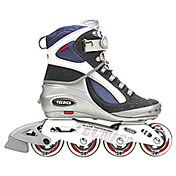
|
|
|
|
Go to the Playright Sporting Goods Catalog!!!!! BUYERS GUIDES   In-line Skates How To Buy In-line Skates In-line skating is a fun, healthy activity for people of all ages. The various types of in-line skates include recreational, aggressive, speed and hockey. Click on the links below for more information. Types of in-line skates: Recreational, Aggressive, Speed, Street Hockey, Women's. Tips on Skate construction: Wheels, Frames, Uppers, Bearings, Brakes, Closures. Determining your skate size There is a skate type for each style of skating and level of expertise. Designed for a leisurely rides in the park or around the neighborhood, and fitness activity Comfort and durability are priorities Usually made with a hard outer frame and a soft or hard boot Typically equipped with 4 wheels with a wheel size from 70-80 mm Designed for a skating style that includes stunts, jumping, riding rails, and half pipes Aggressive skates are designed to be very solid and sturdy Smaller, hard wheels provide maneuverability and durability Skates include special modifications to allow skaters to ride rails and ramps Lighter and less robust than recreational or aggressive skates A completely different skate designed strictly for fast skating Longer frames with a fifth wheel for more stability and longer strides Larger wheels enhance acceleration No braking system Similar in style and construction to traditional ice hockey skates Very durable, with leather uppers and significant padding for protection Usually have a lace-up closure system Smaller wheels enhance turning ability Sometimes have--large wheels in back and smaller wheels in front--for control No braking system Designed with a wider forefoot, narrower heel, and higher instep Lower cut in the back accommodates a woman's calf Each style of skate has a number of similar components. In-line skating wheels are usually made of polyurethane, a molded compound that allows for different thickness and wheel hardness. Typical wheel diameters are from 70-80 mm Larger wheels are designed for speed Smaller wheels are designed for maneuverability Recreational skate wheels Recreational skates usually come with 70-72 mm wheels for a low, stable center of gravity Midsize wheels are 72-76 Higher grade recreational skates come with larger wheels (up to 80 mm) to allow faster skating Hockey wheels The stability and maneuverability of smaller wheels are desirable to hockey players Hockey wheels tend to be more tapered than other wheels for better stability in a turn Fitness and cross-training wheels and Agressive wheels Very small wheels (55-67 mm) are best for stunt skates Wheels this size are also very hard to withstand grinding and jumping Speed wheels These wheels are larger (78-80 mm) and to assist acceleration and energy return Race wheels have the thinnest profile of all wheels for more speed but less stability Changing your wheels To avoid excessive, uneven wear, they need to be rotated at least once a week, or after every use for agressive skaters Wheels should be changed when they show excessive wear on all sides. Skating with worn wheels is unsafe. Hardness Wheel hardness is measured in durometers. Lower numbers indicate a softer wheel and higher numbers indicate a harder wheel. Durometer is denoted by the suffix "A" (example - 80A) The typical recreational in-line skate wheel is 78A or 82A Softer wheels are good for winter and provide a softer ride. Harder wheels are better in the summer when the pavement is hot and the wheels tend to soften. Frames hold skate components in place Most recreational frames are made of aluminum alloy or nylon and fiberglass composites. Make sure the frames you select are designed for the type of skating you plan to do Metal frames are stiffer, faster, and lighter, but typically cost more Recreational skate uppers are usually made from synthetic materials that offer durability, comfort and breathability Hockey skates are usually made of leather composites Liners Many boots contain a cushioning liner usually made of a foam material Sometimes reinforced along the toe and sides for protection (in hockey skates) or increased stability Hard shell Constructed of molded plastic and similar to a ski boot The lower half covers and protects the foot The upper half wraps around and supports the ankle The two halves are connected with a hinge system that allows the ankle and boot to flex forward naturally Soft boot Made with an external (and sometimes internal) plastic cuff to provide support, like a hiking boot Provide a good fit and performance Very breathable and lightweight Generally secured by laces Bearings are the seven or eight balls at the center of each wheel Each bearing has an ABEC rating that indicates the precision of their manufacturing The higher the rating, the more precise the manufacture and the better the performance and speed The general ABEC range is ABEC-1, ABEC-3, ABEC-5 Bearings are either serviceable or non-serviceable Serviceable bearings have a metal shield with a removable "C" ring, or a plastic/rubber type removable shield. These may be taken apart to be cleaned, lubricated or replaced. Non-serviceable bearings have a metal shield that protects them. These only need to be wiped off with a clean cloth. Bearings don't need to be cleaned after every use, but if they become wet, they should be cleaned and dried Never lubricate the outside of a bearing because that will attract dirt and contaminants Most manufacturers offer different braking systems The most common form of baking system is a pad or cylinder on the rear wheel that stops movement by applying pressure on the heel Hockey skates and speed skates normally do not include braking systems Most brake pads have a "wear line" that indicates how much performance is left in the brake. The brake pad should be replaced before this wear line is reached. Some manufacturers do offer mechanical braking systems that make stopping easier to learn There are two primary forms of closure systems on in-line skates Buckles Found mostly on recreational skates Skates with buckle closures are the quickest to put on and take off The number of buckles varies from 2 to 5 Laces Similar to regular shoe laces Less expensive than buckle closures, and offer a uniform closing Allows for more adjustment variations Usually found on hockey skates Determining your skate size Determining your proper skate size is essential to a comfortable fit The size of your skate will be the same as the size shoe you wear For the perfect fitting skates, see Determining Your Shoe Size before making your purchase decision |